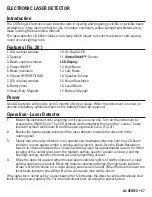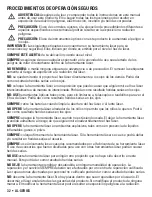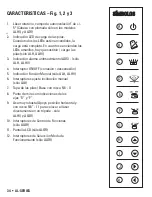
AL-SERIES • 21
CALIBRATION
Your ALHV Series Self-Leveling Laser is a sealed instrument and is calibrated to precise
accuracies at the factory. However, a calibration check is recommended before the initial use of
your laser, and then periodically from that point forward. Be sure to allow time (up to 60 seconds)
for the instrument to completely self-level before each check.
Upright Position Peg Test – X axis (All models)
1.
To test the X axis, mount the laser on a tripod or a level, sturdy surface and place
100 feet (30m) away from a wall. Face the “X+” side of the instrument to the wall (Fig. 16).
2.
Press the (
A
) button and allow the instrument to self-level. Using the laser detector, locate
and mark the position of the laser line on the wall Position (A).
3.
Loosen the instrument from the tripod and rotate the instrument 180°. Ensure that the height
of the tripod does not change, as this will affect your results. Secure and re-level
the instrument.
4.
Again, using the laser detector, locate and mark the position of the laser on the
wall (Position (B)).
5.
Mark the centerline between Position A and Position B (Position (C)). Calibration is
necessary if the vertical difference between Position A and Position C or Position B and
Position C is greater than the specified accuracy.
Repeat the above steps to ensure a correct reading. If the distance is greater than specified
accuracy, you will need to calibrate the X axis.
NOTE:
For ALHV, ALHV-G, and ALGR Spot Mode can be used without detector if designed
Upright Position Calibration– X axis
model ALH (Fig.16)
1.
Power On the instrument with the (
A
) button while holding the (
B
) button down, then
release the (
A
) button. You will know if Calibration Mode is activated when the Battery and
Anti-Drift LEDs flash alternately. Then, the Anti-Drift LED will remain lit; this
indicates that the instrument is calibrating within the X axis.(Fig. 17)
2.
The (
H
)and (
I
) buttons change the axis increments. The (
H
) button will produce a
positive (+) increment, and the (
I
) button will produce a negative(-) increment.
NOTE:
for ALH Pressing the (
B
) button will toggle between X and Y axis for calibration. Anti-Drift
LED on indicates X- axis is selected.
3.
You must raise or lower the beam to center between positions A and B (position C) on the
target. The instrument will react to “+” and “–” input within the X+ quadrant. The instrument
DOES NOT react to adjustments until the instrument is forced to re-level (i.e. rotate
and re-check point (A)).
If B is below A, increase the increment (+).
If B is above A, decrease the increment (-).
4.
The adjustments are automatically saved.
You must now repeat the peg test to insure you have made the correct calibration. A peg test can
be done in Calibration Mode.
Summary of Contents for ALGR
Page 2: ...2 AL SERIES LD440 3 3...
Page 8: ...8 AL SERIES 1 5 4 8 9 7 3 2 6 ALH Fig 1...
Page 9: ...AL SERIES 9 ALHV ALHV G Fig 2 8 9 7 ALHV A L H V 1 3 4 2 13 6...
Page 35: ...AL SERIES 35 1 5 4 8 9 7 3 2 6 ALH Fig 1...
Page 36: ...36 AL SERIES ALHV ALHV G Fig 2 8 9 7 ALHV A L H V 1 3 4 2 13 6...
Page 63: ...AL SERIES 63 1 5 4 8 9 7 3 2 6 ALH Fig 1...
Page 64: ...64 AL SERIES ALHV ALHV G Fig 2 8 9 7 ALHV A L H V 1 3 4 2 13 6...
Page 92: ...92 AL SERIES 1 5 4 8 9 7 3 2 6 ALH Fig 1...
Page 93: ...AL SERIES 93 ALHV ALHV G Fig 2 8 9 7 ALHV A L H V 1 3 4 2 13 6...
Page 120: ...120 AL SERIES 1 5 4 8 9 7 3 2 6 ALH Fig 1...
Page 121: ...AL SERIES 121 ALHV ALHV G Fig 2 8 9 7 ALHV A L H V 1 3 4 2 13 6...
Page 149: ...AL SERIES 149 1 5 4 8 9 7 3 2 6 ALH Fig 1...
Page 150: ...150 AL SERIES ALHV ALHV G Fig 2 8 9 7 ALHV A L H V 1 3 4 2 13 6...






























